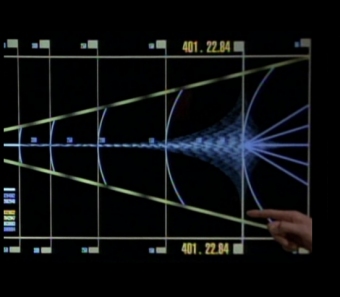|

In Star Trek, a subspace fracture is a rip in the
space-time continuum, formed by the detonation of polaric ion energy. A
fracture in subspace can cause temporal anomalies(VOY: "Time and
Again"). In an alternate timeline, the USS Voyager encountered a Class
M planet devastated by the detonation of polaric ion energy. The
explosion resulted in the formation of subspace fractures around the
planet's surface. Kathryn Janeway and Tom Paris were caught in one of
the fractures and were pulled back in time before the destruction of
the planet.
It is unclear what the 'polaric ion energy' that forms
these fractures is. Positive ions, however, can be an alternative
energy source and are used in ion propulsion. An ion is an atom or
molecule which has lost or gained one or more electrons, giving it a
positive or negative electrical charge. Any atom or molecule containing
an unequal number of electrons and protons and therefore carrying a net
positive or negative charge. Cations are positively charged ions,
formed when an atom loses electrons in a reaction, forming an 'electron
hole'. A positive ion remains if an electron is removed, for example,
by being struck by a photon or fast charged particle of sufficient
energy to overcome the binding energy of that electron.
Ion propulsion is a form of electric space propulsion in
which ions are accelerated by an electrostatic field to produce a
high-speed (typically about 30 km/s) exhaust. An ion engine has a high
specific impulse (making it very fuel-efficient) but a very low thrust.
Therefore, it is useless in the atmosphere or as a launch vehicle, but
extremely useful in space where a small amount of thrust over a long
period can result in a big difference in velocity. This makes an ion
engine particularly useful as a final thruster, for orbital maneuvering
or station-keeping, and as a means of propelling deep-space probes by
thrusting over a period of months to provide a high final velocity.
One of the most promising new developments in ion
propulsion is the DS4G (dual-stage 4-grid) ion engine, developed by the
European Space Agency and a group at the Australian National
University. This was first tested by ESA in 2005. The DS4G thruster
achieves much higher voltages to be used than previously thought
possible, resulting in a more powerful post acceleration of the
extracted ions. The thruster was tested in a large space simulation
chamber in the ESA Technology centre in the Netherlands at a remarkable
30,000 V and produced an ion exhaust plume that travelled at 210 km/s –
over four times faster than state-of-the-art ion engine designs
achieve.
|
|
